Lose Your Butt Fat
Losing fat from the butt is a common fitness goal. There are many ways a person can achieve this. There are three major muscles in the butt. These are the gluteus maximus, the gluteus minimus, and the gluteus medius.
While it is not possible to spot-reduce fat loss in one particular area, cutting down on overall body fat while toning the butt muscles can lead to leaner, better-defined buttocks. In this article, we detail exercises that help people lose fat throughout the body while adding shape to the butt and thigh muscles. We also list other methods that can help people achieve their desired body shape.
Exercises
Try the following exercises to lose fat from the butt and to tone the muscles in the thighs and glutes:
1. Running
Running is an excellent exercise for full-body weight loss. Running tones the leg and butt muscles, which gives the thighs and buttocks a more defined shape. This aerobic activity also improves heart and lung function, and it strengthens the lower body. Also, aside from supportive shoes, it requires no special equipment. Running is better than walking for fat loss, as it burns more calories. A 2012 study found that, over 1,600 meters, people of average fitness burned 372.54 calories while walking and 471.03 calories while running.
However, the study authors conclude that even if a person is unable to take up running, walking is also a very good option for burning calories and fat compared with resting.
2. High-intensity interval training (HIIT)
Busy people who want to lose butt fat can take up high-intensity interval training (HIIT). According to a worldwide survey of fitness trends for 2018, HIIT is the most popular fitness trend globally. HIIT involves putting maximum effort into one specific activity for a short period. This is followed by a longer period at a slower pace. HIIT sessions are intense workouts, so they tend to be shorter in duration than moderate-intensity activities.
For example, after a warmup period, HIIT may involve the following:
- running on a treadmill at 7 miles per hour (mph) for 1 minute
- running for 2 minutes at 5 mph
- repeating this pattern for 15 minutes or so before cooling down
Research from 2011 suggests that HIIT may be more effective at reducing body fat than other types of exercise. Another study reports that HIIT is a good strategy for controlling obesity because of its time-efficiency.
3. Step-climbing
Climbing steps is an easy way to tone the glutes while also keeping the heart and lungs healthy. Step-climbing boosts strength and muscle tone in the butt and upper legs. There are various ways to work these muscles:
- using stepping machines at a gym
- walking up flights of stairs
- hiking uphill
- using a climbing or bouldering wall
Step-climbing can provide other health benefits, too. One small study from 2005 on 15 women found that climbing flights of stairs up to five times per day had a measurable impact on oxygen uptake and reduced low-density lipoprotein, or “bad,” cholesterol. In this study, the women began by climbing a flight of 199 stairs once each day in week 1, then gradually increasing climbs to five times each day by week 7. They made no other dietary or lifestyle changes while taking part in this study.
4. Squats
Squats are a major part of many exercise plans. This is likely due to their ability to work several muscles in the butt, legs, and abdomen at the same time. One 2009 study, which appeared in the Journal of Orthopaedic and Sports Physical Therapy, examined the effects of various exercises on the gluteus maximus and gluteus medius. The scientists found that single-leg squats were a good option for activating both the gluteus maximus and the gluteus medius.
To perform a single-leg squat: 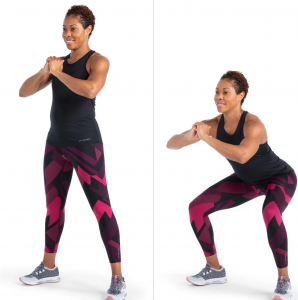
- Extend the arms in front of the body.
- Stand on the left leg and extend the right leg straight in front, as high as possible.
- Slowly lower the butt as close as possible to the floor while keeping the leg elevated. The back should be straight and the left knee in line with the left foot.
- Return to the starting position. Repeat several times before switching to the right leg.
If it is not possible to perform one-leg squats, regular squats are also effective. To do these:
- Extend the arms in front of the body. Keep the feet shoulder-width apart.
- Slowly lower the butt as close as possible to the floor, without losing balance. The back should be straight, and the knees should not travel out in front of the toes.
- Return to the starting position. Repeat several times.
- To increase the intensity, hold weights in the hands while squatting.
Another variation is the split-squat, during which a person performs squats with their legs apart. A small-scale 2017 study found that split-squats had the highest impact on the gluteus maximus, compared with deadlifts and good-mornings.
5. Lunges
Lunges are another lower-body strength exercise that activates and tones the gluteus maximus. Variations include sideways, forward, and transverse lunges. The basic forward lunge also works the thighs and calves. To perform a lunge:
- Stand with the feet hip-distance apart.
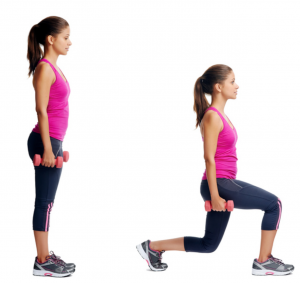
- Take a large step forward with the left leg.
- Slowly lower the body, bending both knees to 90 degrees. Do not allow the right knee to touch the ground or the left knee to travel past the toes of the left foot.
- Return to the standing position. Repeat several times.
6. One-leg Deadlift
Deadlifts work the lower body, improve balance, and strengthen the abdominal muscles and lower back. Doing one-leg deadlifts also activates the gluteus muscles.
Follow these instructions to do a one-leg deadlift: 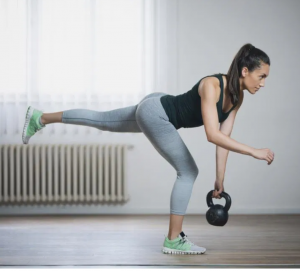
- Stand on one leg with the hands by the sides.
- Stretch the other leg out behind. Keep the back flat and the shoulders back.
- Lean forward from the hips until there is a stretch in the hamstrings. Do not let the chest drop below the hips.
- Return to the starting position. Repeat several times, then switch sides.
If this is too intense, lightly rest the non-supporting leg on the floor. To increase the exercise intensity, use hand-held weights.
7. Side-lying Hip Abduction
Side-lying hip abduction exercises are effective for strengthening the gluteus medius muscle. To do this exercise: 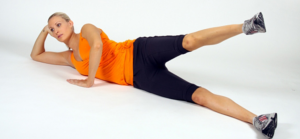
- Begin by lying on one side and supporting the head with the arm or hand. Keep the knees straight and feet together.
- Slowly raise the top leg as high as possible without turning the pelvis backward or forward.
- Lower the leg slowly to return to the starting position. Repeat several times on each side.
Use ankle weights to increase the intensity of this exercise.
8. Lateral band walk
Strengthen and stabilize the hips and knees with a lateral band walk, which also works the gluteus medius muscle. This exercise is a useful warmup activity before running, jumping, and other activities.
To do the lateral band walk: 
- Take a resistance band and place it under the balls of the feet. Ensure that the band stays flat against the shoes.
- Stretch the legs to shoulder-width apart. Distribute the weight evenly over both feet.
- Bending the knees slightly to achieve a semi-squat position, squeeze the glutes and core muscles.
- With one foot, take a small step of around 3 inches to the side. Move the other foot in the same direction, again approximately 3 inches.
- Take 10 steps like this, then do the same in the other direction.
To make this exercise more difficult, choose a band with a higher level of resistance. For the best results, combine the activities listed above with these other tips for weight loss:
9. Work Out Regularly
Consistency is key to seeing results. Maintain an exercise routine that combines aerobic exercises and strength training for the best whole-body benefits. The Physical Activity Guidelines Advisory Committee suggest that adults do at least 150 minutes of moderate-intensity aerobic activity, or 75 minutes of vigorous-intensity activity, weekly. They also recommend muscle-strengthening activities at least twice weekly.
10. Eat a Balanced Diet and Practice Portion Control 
To lose weight, a person must take in fewer calories than the body burns. This is called a calorie deficit. To lose 1 pound, a person needs a calorie deficit of 3,500 calories. Practicing portion control is a quick way to do this. Research stresses the importance of managing portion sizes to reduce calorie intake and prevent weight gain.
Simple strategies for staying satisfied on a healthful diet include:
- filling up on fiber-rich foods, such as fruits, vegetables, beans, and lentils
- eating lean sources of protein, including fish, tofu, and legumes
- adding a source of beneficial fats to meals, such as olives, nuts, seeds, and avocado
- avoiding processed foods and takeout meals
- skipping sugar-filled foods and sodas
- swapping refined carbohydrates (white bread, white pasta, or white rice) for wholegrain versions (wholegrain bread, brown pasta, or brown rice)
- drinking a glass of water before meals
- chewing food slowly
11. Reduce stress
Stress causes the body to release a hormone called cortisol. Cortisol affects metabolism and stimulates cravings for sugar and other refined carbohydrates. This causes fat to build up in the body.
People who experience high levels of stress are more prone to feeling tired, so it can be tempting to order fast food instead of cooking a healthful meal at home. It might also mean that they exercise less. These habits can quickly lead to weight gain.
The following tips can help a person reduce stress levels:
- getting regular exercise, even if just a daily walk
- eating a balanced diet
- practicing mindfulness and meditation
- breathing deeply
- trying progressive muscle relaxation
- spending time in nature
- evaluating priorities and reducing sources of stress
12. Get enough sleep

Get plenty of sleep!
Lack of sleep may negatively affect metabolism and hormone levels in the body. Being tired can also lead to cravings for junk food and fast food. Together, these effects increase the risk of weight gain and make it more difficult for a person to lose weight.
Break the cycle of poor sleep by establishing a regular nightly routine. Aim to go to bed at the same time each night and get up at the same time each morning. It is essential to get 7–9 hours of sleep each night. Some people nod off more easily after taking a warm bath, drinking a cup of chamomile tea, or simply reading a book.
Summary
With regular exercise that includes aerobic activity and targeted toning exercises, losing butt fat is an achievable goal. For the best results, a person can use specific exercises, physical activity, and diet and lifestyle changes.
If these methods do not work, even with exercise and a healthful diet, a person may want to consider seeing their doctor. There may be an underlying reason for this, such as a thyroid disorder. It may also be helpful to work with a dietician, personal trainer, or both.
Credit to MedicalNewsToday
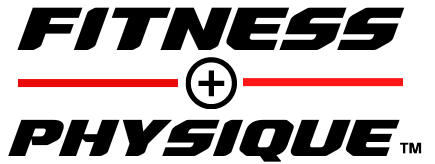
 Next Post
Next Post